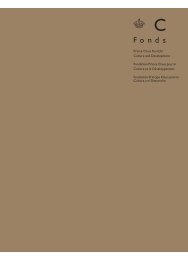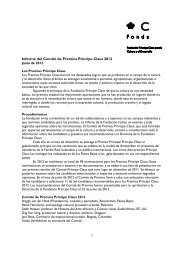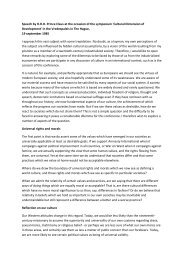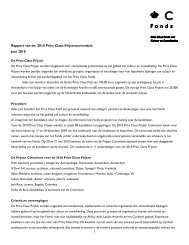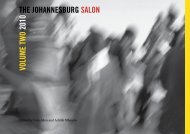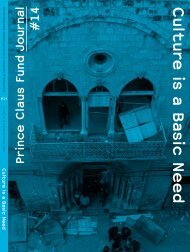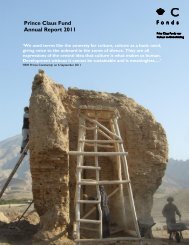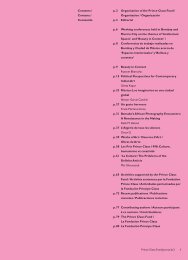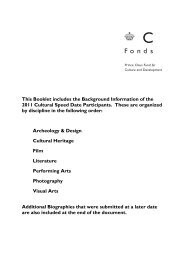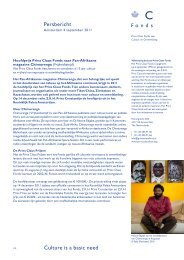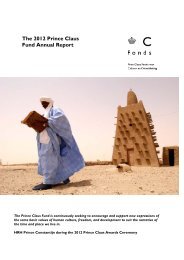3 summer 2011 - Prince Claus Fund
3 summer 2011 - Prince Claus Fund
3 summer 2011 - Prince Claus Fund
- No tags were found...
Create successful ePaper yourself
Turn your PDF publications into a flip-book with our unique Google optimized e-Paper software.
parties, chose the symbol of a book (Figure 6) and promoted its perceptionas the Qur’an (known in Arabic as Al Kitab or The Book). These religiousovertones acquired additional relevance with the party’s unexpectedvictory in the 2002 elections, something that the analysts attributed to anexpression of the Muslim electorate’s disapproval of government supportfor the West concerning the Iraq war.4–6.Another oft-quoted example laden with religious sentiment is that ofthe sword (Figure 9), the symbol of the liberal Pakistan People’s Party(PPP) until the 1988 elections. Not only does it traditionally imply power,protection and courage but it semantically and historically refers to theword ‘Zulfiqar’ which is the name of the legendary sword of the fourthCaliph of Islam. When the EC decided ahead of the 1988 elections thatthe sword would no longer be a choice, the PPP selected the teer or arrow i(Figure 10) to replace it. Thappay pey thappa, teer pey thappa (Stamp afterstamp, stamp on the arrow) has since become a popular party slogan.saima zaidi230The selection of a symbol could be inextricably linked to its regional,agrarian, historical or religious connotations. An example of the regionalcontext were the Peshawari Chappals—a pair of leather sandals, namedafter the capital city of the North-West Frontier Province—selected bythe Pakhtoonkhwa Qaumi Party in elections 2002. Tools of the tradesuch as the spade, the karandi (trowel), and the tractor were chosen bythe Punjab National Party, Labour Party Pakistan ii and National People’sParty—parties representing the working class. In fact, the dual arrangementof the sickle and hammer iii and the charkha (wheel) iv recall earlierpotent political associations. The latter, reminiscent of the Independencemovement, forms a part of the Indian national standard, and inPakistan represents the Hindus and Scheduled Castes’ Party.Animals are an enduring visual phenomenon in the subcontinent, asaffirmed by the humped bull, the elephant and the unicorn of the IndusValley seals dating back to 4000 BCE. The Pakistan Muslim League-Nawaz(PML-N) selected the sher (tiger or lion) as its election symbol and fullyexploited its well known characteristics of majesty, strength, justice andmight as the king of the jungle. One poster featured party chief NawazSharif and a lion alongside a famous Urdu quotation attributed to thelegendary fighter Tipu Sultan: ‘To live for one day as a lion is better thanliving for a hundred years as a jackal.’ 6 In the Punjab, the stronghold of thei. In Greek mythology it is the weapon of Apollo and Diana, signifying the lightof Supreme power. 7 According to PPP leader Syed Taj Haider, the arrow as asymbol was selected by party worker Akhtar Mirza at the request of the PPP’slate chairperson, Benazir Bhutto. ‘Mirza [randomly] opened Shah Jo Risalo a bookbased on the spiritual poetry of Hazrat Shah Abdul Lateef Bhittai (a Sufi saint ofSindh). The first thing he read was [the line] Sabr Jein Jo Seer…Teer Na Gussay Tin Jo.In a rough translation, this means ‘the one whose city is patience…the arrow shallnever hit (Narrated to Shah Jilani, reporter, The Daily Times).ii. In the general elections 2002.iii. Symbolic of Communism. The hammer in Pakistani politics is the symbol of theTameer-e Pakistan Party (tameer: construct).iv. The navy-blue wheel with 24 spokes, known as the Ashoka Chakra ‘the wheel ofRighteousness’, is used on the Indian flag and was taken from the Lion Capitalof Ashoka at Sarnath. Thus, the charkha (spinning wheel), a symbol of economicregeneration of India under Mahatma Gandhi, evolved into the chakra, the wheel.Figures 3–12. Wall chalkings of election symbolsSymbols are usually painted on walls in partycolours. Additionally, the name of the party inacronyms, the names of the party leaders, slogansas well as the party flag, are included.Figure 4 shows the symbol of a huqqa (waterpipe)next to which is written ‘Election symbolwaterpipe’. Figure 5 shows a rickshaw with thename Irfanullah Khan Marwat, a candidatefor a provincial assembly seat. In Figure 6 nextto the book (election symbol of the MMA)is written ‘Only stamp the book’ urging theviewer to ‘Make the book a success’. Figure 7depicts the fist accompanied by the slogan ‘Longlive Ghinwa Bhutto’. Figure 8 shows an ‘axe’within the red flag for Jeay Sindh, on the wayto Thatta, 2007. Figure 9 shows the flag of thePPP and its earlier symbol, the sword, paintedoutside the Bhutto mausoleum at Garhi KhudaBakhsh (2008), while in Figure 10 the arrowis painted in the PPP colours. Sponsored by theMalir District, it carries the name of the candidateSalman Abdullah Murad for the SindhAssembly seat. Figure 11 shows a stencil of thekite in party colours of the MQM from the 2002elections. In 2008, the party decided againstdefacing public property by not advertising onwall chalkings. Figure 12 displays the bright redlantern of the ANP along with its red flag.Figure 13. Activists of the PML-N flashing Vsigns gathered around a car with a stripedanimal-print skin stretched over its hood—avisual reference to their election symbol, thesher (lion or tiger).<strong>Prince</strong> <strong>Claus</strong> <strong>Fund</strong> Reader #1 · Summer <strong>2011</strong> · 20



